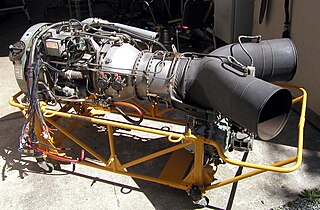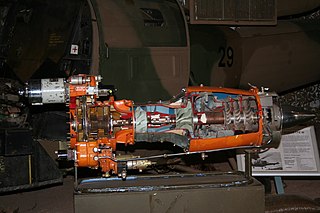
A tip jet is a jet nozzle at the tip of some helicopter rotor blades, used to spin the rotor, much like a Catherine wheel firework. Tip jets replace the normal shaft drive and have the advantage of placing no torque on the airframe, thus not requiring the presence of a tail rotor. Some simple monocopters are composed of nothing but a single blade with a tip rocket.

The Bristol Siddeley Nimbus, later known as the Rolls-Royce Nimbus, was a British turboshaft engine developed under license by Blackburn Aircraft Ltd. from the Turbomeca Turmo in the late 1950s. It was used on the Westland Scout and Westland Wasp helicopters.

The Allison Model 250, now known as the Rolls-Royce M250, is a highly successful turboshaft engine family, originally developed by the Allison Engine Company in the early 1960s. The Model 250 has been produced by Rolls-Royce since it acquired Allison in 1995.

The Turbomeca Astazou is a highly successful series of turboprop and turboshaft engines, first run in 1957. The original version weighed 110 kg (243 lb) and developed 240 kW (320 shp) at 40,000 rpm. It was admitted for aviation service on May 29, 1961, after a 150-hour test run. The main developing engineer was G. Sporer. It was named after two summits of the Pyrenees.

The Turbomeca Artouste is an early French turboshaft engine, first run in 1947. Originally conceived as an auxiliary power unit (APU), it was soon adapted to aircraft propulsion, and found a niche as a powerplant for turboshaft-driven helicopters in the 1950s. Artoustes were licence-built by Bristol Siddeley in the UK, Hindustan Aeronautics Limited in India, and developed by Continental CAE in the US as the Continental T51. Two major versions of the Artouste were produced. The Artouste II family, mainly used in the Aérospatiale Alouette II helicopter, had a one-stage centrifugal compressor and a two-stage turbine, with gearbox-limited power of 300 kW (400 hp). The Artouste III family, mainly used in Aérospatiale's Alouette III and Lama helicopters, had a two-stage axial-centrifugal compressor and a three-stage turbine, with gearbox-limited power of 420–440 kW (560–590 hp).

The Turbomeca Turmo is a family of French turboshaft engines manufacturered for helicopter use. Developed from the earlier Turbomeca Artouste, later versions delivered up to 1,300 kW (1,700 shp). A turboprop version was developed for use with the Bréguet 941 transport aircraft.

The Turbomeca Palas is a diminutive centrifugal flow turbojet engine used to power light aircraft. An enlargement of the Turbomeca Piméné, the Palas was designed in 1950 by the French manufacturer Société Turbomeca, and was also produced under licence by Blackburn and General Aircraft in the United Kingdom and Teledyne Continental Motors in the United States as the Continental Model 320.

The Sud-Ouest SO.1221 Djinn is a French two-seat light helicopter designed and manufactured by aircraft manufacturer Sud-Ouest (SNCASO), which was later merged into Sud Aviation. It was the first production French helicopter, as well as being one of the first practical European helicopters to be produced. The Djinn was also the first rotorcraft to harness tip-jet propulsion to enter production.

The Boeing T50 was a small turboshaft engine produced by Boeing. Based on Boeing's earlier Model 500 gas generator, the T50's main application was in the QH-50 DASH helicopter drone of the 1950s. An up-rated version designated Model 550 was developed to power the QH-50D and was given the military designation T50-BO-12.

The Continental CAE T51 was a small turboshaft engine produced by Continental Aviation and Engineering (CAE) under license from Turbomeca. A development of the Artouste, it was followed by three additional turboshaft engines, the T72, the T65, and the T67. However, none of these engines, including the T51, entered full production. CAE abandoned turboshaft development in 1967 after the XT67 lost to the Pratt & Whitney Canada PT6T (T400) to power the Bell UH-1N Twin Huey.

The Fairey Ultra-light Helicopter was a small British military helicopter intended to be used for reconnaissance and casualty evacuation, designed by the Fairey Aviation Company.

The Power Jets W.1 was a British turbojet engine designed by Frank Whittle and Power Jets. The W.1 was built under contract by British Thomson-Houston (BTH) in the early 1940s. It is notable for being the first British jet engine to fly, as the "Whittle Supercharger Type W1", powering the Gloster E.28/39 on its maiden flight at RAF Cranwell on 15 May 1941. The W.1 was superseded by the Power Jets W.2.
The Fiat 4700 was an Italian turbo-generator developed by Fiat Aviazione under contract to the Italian Defence Ministry and used to power the experimental Fiat 7002 tip jet helicopter.

The Sud-Ouest Ariel is a French two-seat light helicopter designed and built by Sud-Ouest. The helicopter rotors were driven by compressed-air jets at the end of each blade.
The Turbomeca Aspin was a small French turbofan engine produced by Turbomeca in the early 1950s. This geared turbofan design was the first turbofan to fly, powering the Fouga Gemeaux test-bed aircraft on 2 January 1952.
The Turbomeca Orédon was a small French turbo-shaft / Auxiliary Power Unit (APU) engine produced by Turbomeca in the late 1940s.

Many variations of aircraft engine starting have been used since the Wright brothers made their first powered flight in 1903. The methods used have been designed for weight saving, simplicity of operation and reliability. Early piston engines were started by hand, with geared hand starting, electrical and cartridge-operated systems for larger engines being developed between the wars.

The Ivchenko AI-9 is an aircraft auxiliary power unit developed and produced by Ivchenko-Progress and Motor Sich.

The MAN Turbo 6022 is a German gas turbine turboshaft engine for helicopter use. Designed in the early 1960s by BMW the engine powered the third prototype of the MBB Bo 105 on its maiden flight in December 1967.
The Ivchenko AI-8 is an aircraft auxiliary power unit developed and produced by Ivchenko-Progress and Motor Sich.


















